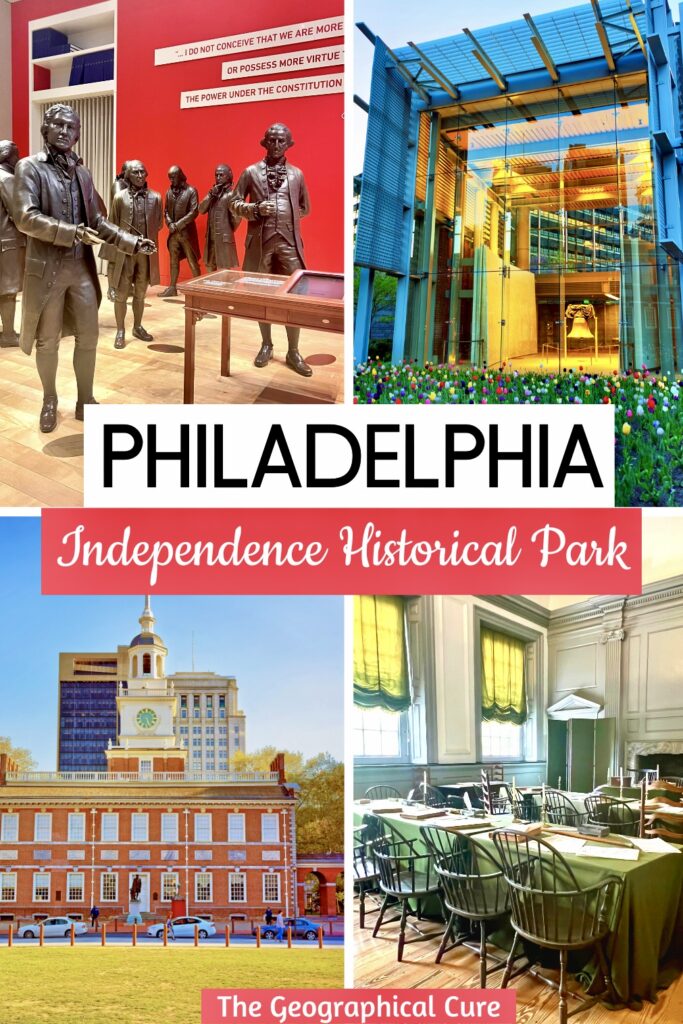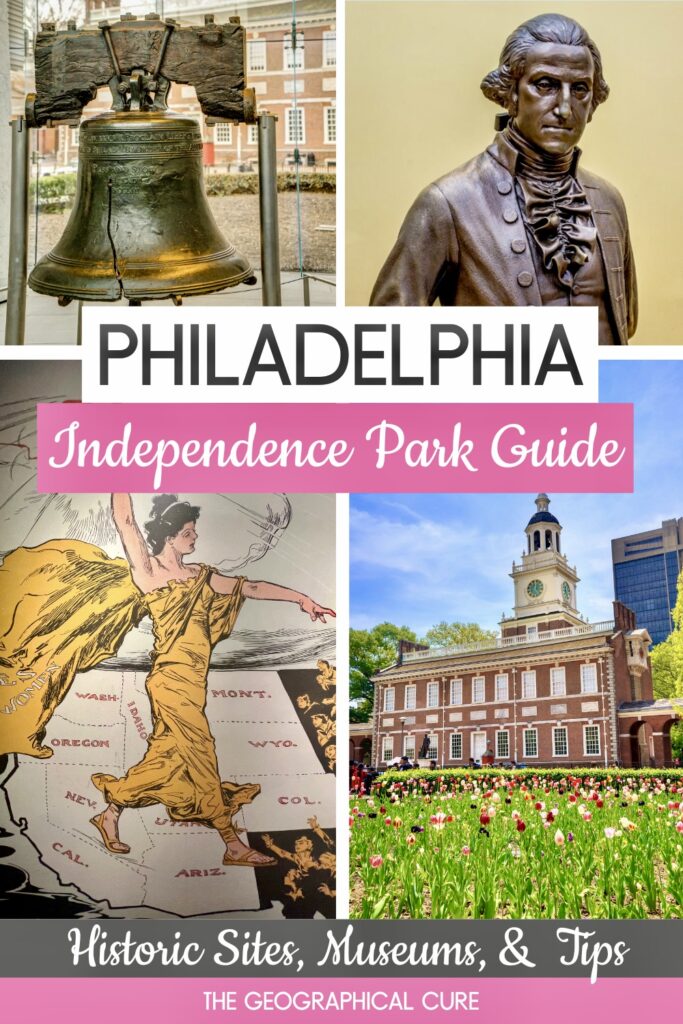Philadelphia is a city brimming with history and tradition. At the heart of the city’s tapestry of American history is Independence National Historical Park. It’s the country’s most historic square mile.
It’s not just a single museum or historic site. Rather, it’s a collection of attractions that hosted events pivotal to American independence or pay tribute to that heritage.
In this park, you can step back in time to the Revolutionary War era. It’s a time when the the colonies broke away from their British overlords. The Founding Fathers launched the future of a nation in this very spot, and the ideals of liberty and democracy took root.
In this comprehensive guide, I tell you everything to see at Independence National Historical Park and give you tips for visiting. It’s in the part of Philly affectionately called Old City.
>>> Click here to book a guided tour of the park
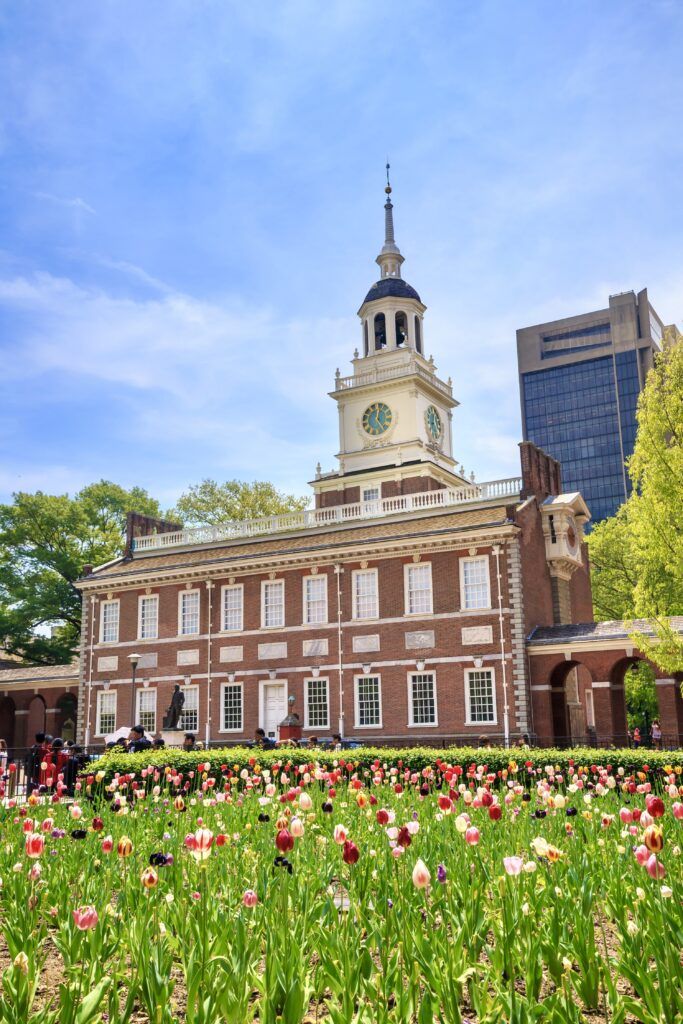
Guide To Independence National Historical Park
Here are the must see landmarks, monuments, and museums in Independence National Historical Park. Almost all these attractions are included in the Philadelphia Go City all-inclusive Pass.
1. Independence Hall
Perhaps the most iconic building in the park, Independence Hall is where both the Declaration of Independence and the United States Constitution were debated, signed, and ratified.
Independence Hall served as the Pennsylvania state house. All three branches of government worked in the building.
Visitors can take a 20 minute guided tour with a park ranger to explore the historic rooms where these important events took place. They are excellent story tellers and will regal you with fascinating tidbits of history.
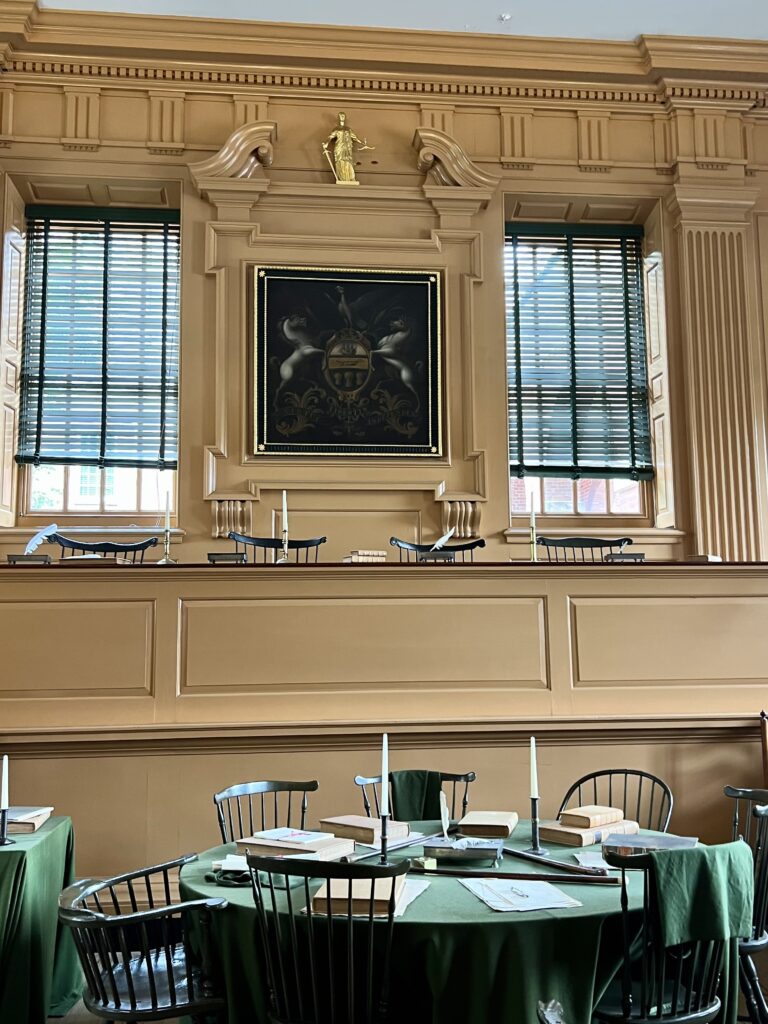
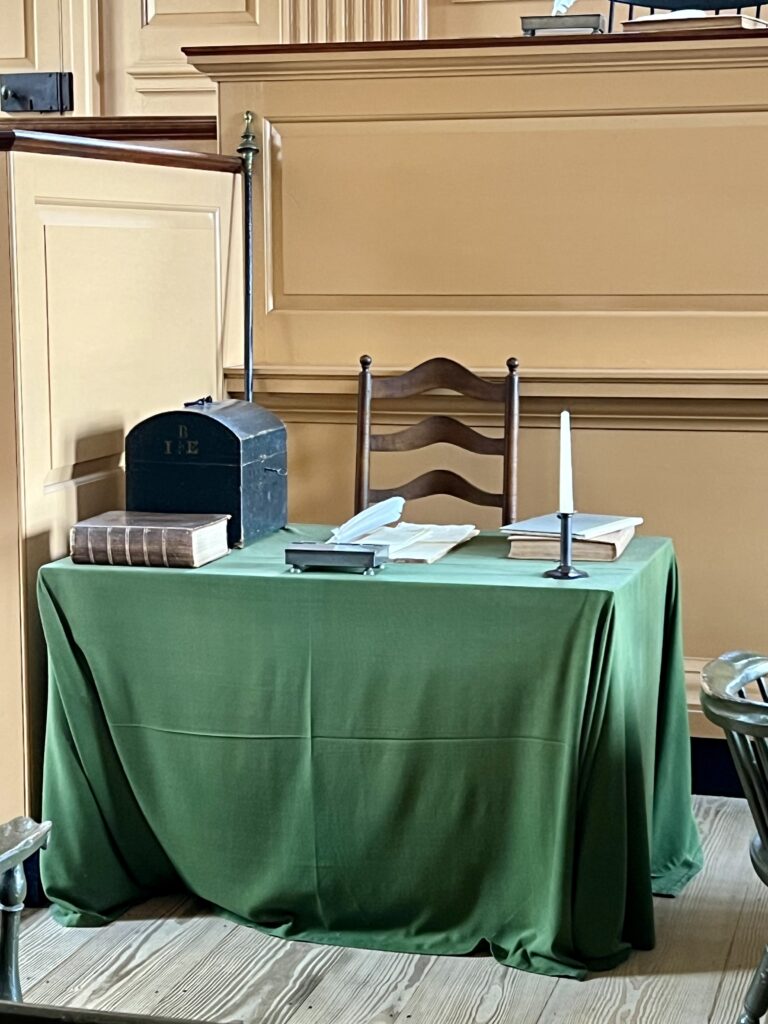
You’ll only see two rooms: the Courtroom and Assembly Hall. Both rooms are beautiful examples of Georgian architecture, though the period furniture is mostly not original.
You can also walk through the bell tower rotunda, dressed in a pretty peacock blue. The tower holds the 13,000 pound Centennial Bell, made to celebrate the nation’s 100th birthday.
Portraits of Louis XVI and Marie Antoinette hang inside the hall, gifts from the monarchs after the Revolutionary War.
The Courtroom was where the Pennsylvania Supreme Court heard cases, beginning around 1743. The room contains a judge’s bench, iron prisoner’s dock, and a table for the lawyers.
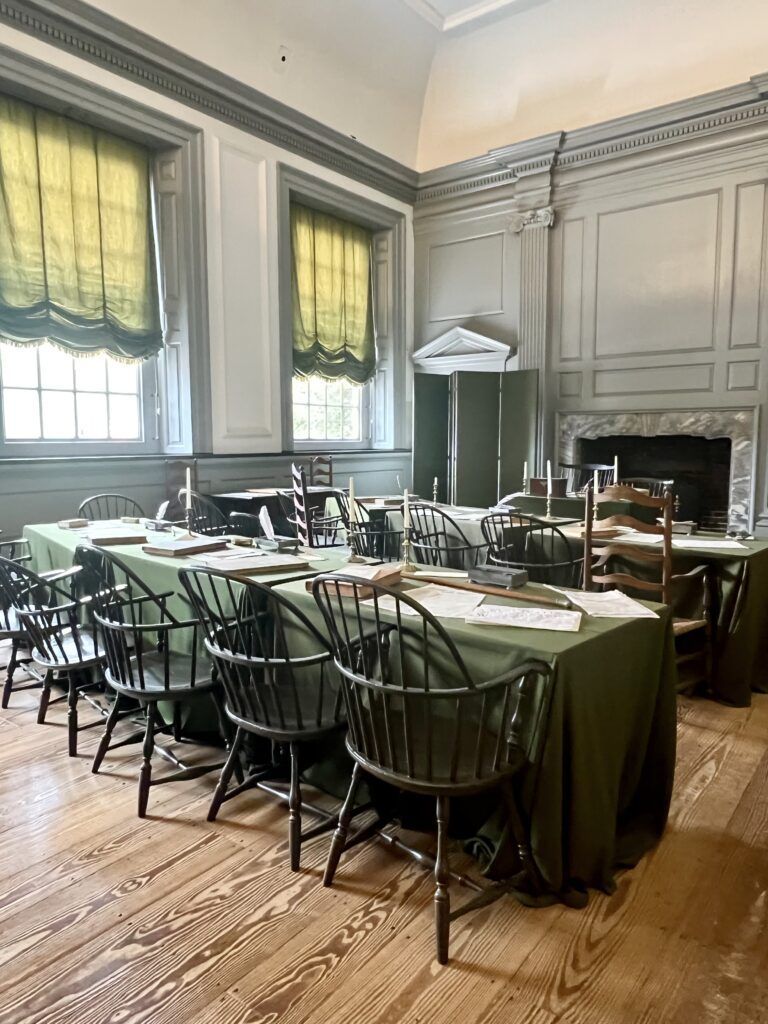
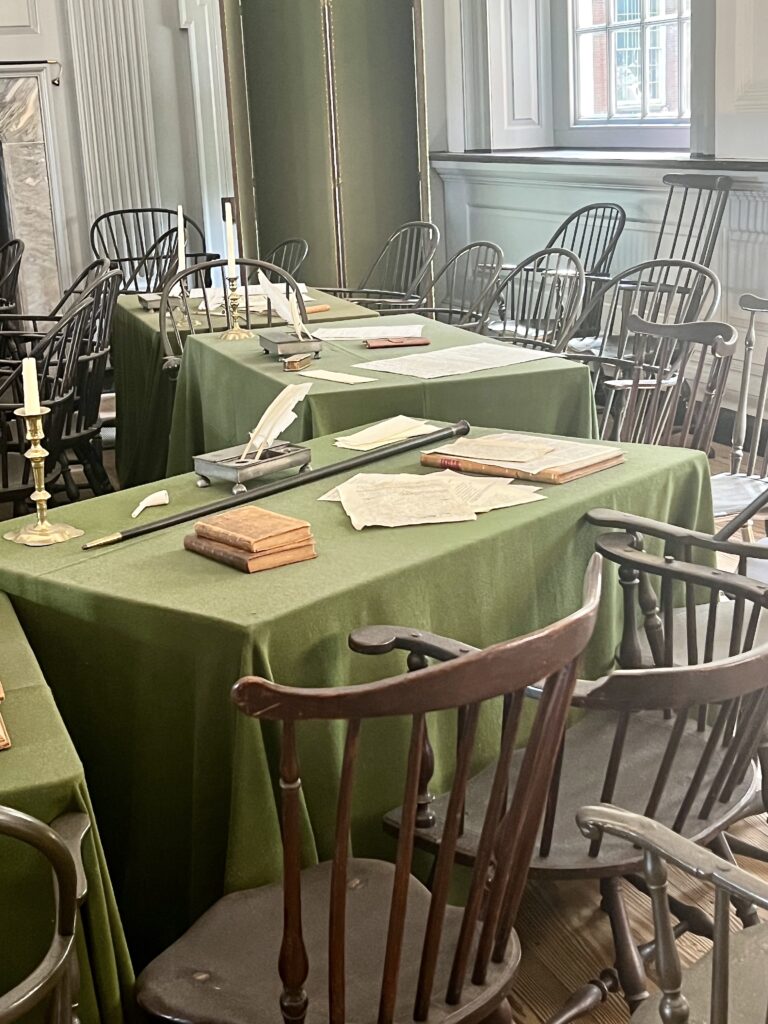
The park ranger will point out the coat of arms above the judge’s bench.
It once held the coat of arms of King George III of England. That was torn down by revolutionaries and replaced with the Pennsylvania coat of arms.
The Assembly Room is what you really come to see. This is where some of the most important events in American history took place and the words “We the People” rang out.
It was the primary meeting place for the Second Continental Congress from 1775 to 1783. This room witnessed the signing of the Declaration of Independence on July 4, 1776, and the the U.S. Constitution on September 17, 1787.
The Georgian room is decorated in muted gray and green hues, with large windows that allow in ample natural light. It features wooden desks and benches arranged in a semi-circle, reflecting the democratic principles of the time.
In the center is the desk with the famous Rising Sun chair of George Washington. It’s the only piece of furniture in the room that’s original.
Legend holds that when he was asked to lead the revolution, Washington promptly ran out of the room thinking he wasn’t up to the task. But he came back the next day, ready to do his duty, and was appointed Commander in Chief of the Continental Army.
>>> Click here to book a founding fathers guided tour
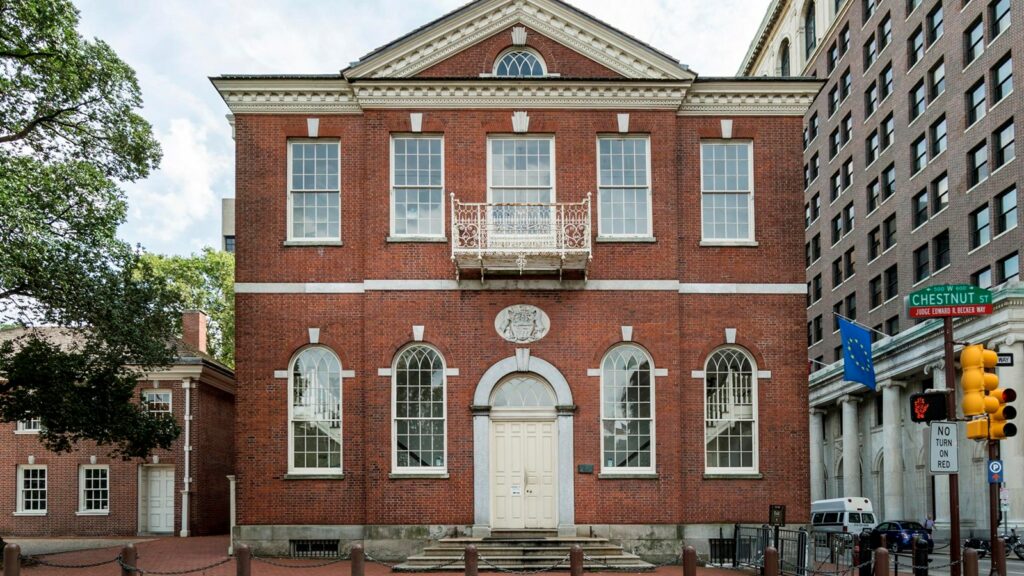
2. Congress Hall
Located next to Independence Hall, Congress Hall served as the home of the U.S. Congress from 1790 to 1800, when Philadelphia was the capital of the United States.
Several crucial events took place in Congress Hall during its tenure as the nation’s capital:
- the presidential inaugurations of George Washington (his second term) and John Adams;
- the Alien and Sedition Acts, significant pieces of legislation in the late 18th century, were debated and passed here;
- the Bill of Rights was ratified during this time, and 10 of the 12 amendments proposed by James Madison were approved, becoming the Bill of Rights.
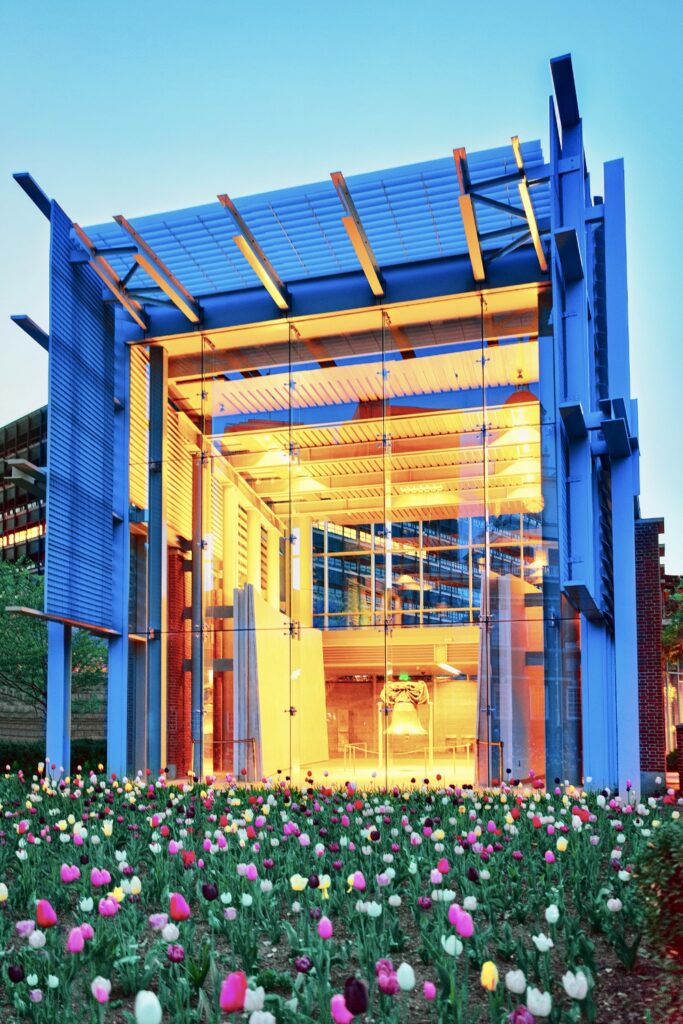
3. Liberty Bell Center
Located just across the street from Independence Hall, the Liberty Bell Center houses the Liberty Bell. It’s one of the most recognizable symbols of American freedom. It’s a sacred relic that embodies the idea of liberty.
The Liberty Bell was originally commissioned in 1751 by the Philadelphia Assembly to mark the 50th anniversary of the state’s constitution.
The bell was cast in London and once topped Independence Hall. The bell is famous for its gap, often called a crack. It runs from the lip to the crown.
The bell was brittle from the outset, due to an unstable mix of metals. The gap is the result of an attempt to fix a thin crack in the bell in 1846, which affected the bell’s tone.
After the repair, the bell rang for George Washington’s Birthday anniversary. But that only made the crack reappear and lengthen. It zigzagged to the top, silencing the bell forever.
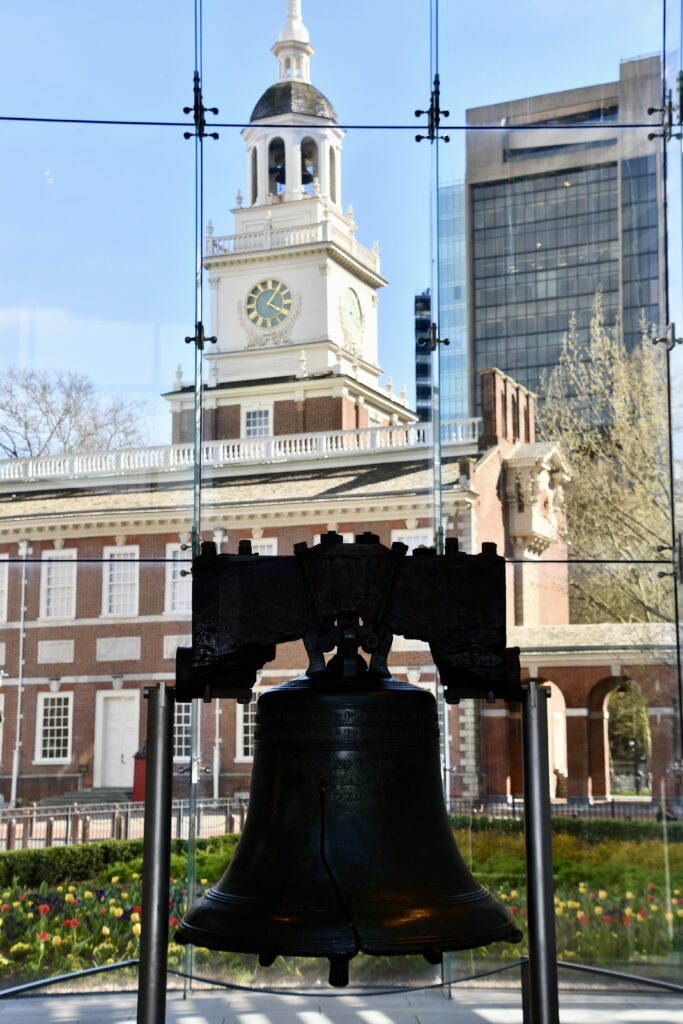
After independence, the Liberty Bell fell into obscurity until 1837. Then, it graced the cover of Liberty, an abolitionist publication. It soon became a widely known as a symbol of the anti-slavery movement, and took on the name The Liberty Bell.
Exhibits in the center give you the bell’s history — details of its origin, casting, and the events that made it famous. There is an interactive exhibit where visitors can virtually “X-ray” the Liberty Bell to see its interior structure.
The exhibits also explore broader themes of freedom and independence in American history. They connect the Liberty Bell’s message of liberty to other important historical events and figures.
The center is free to enter. You just have to go through security. If you don’t want to join the crowds inside, you can admire it through the glass wall on the exterior.
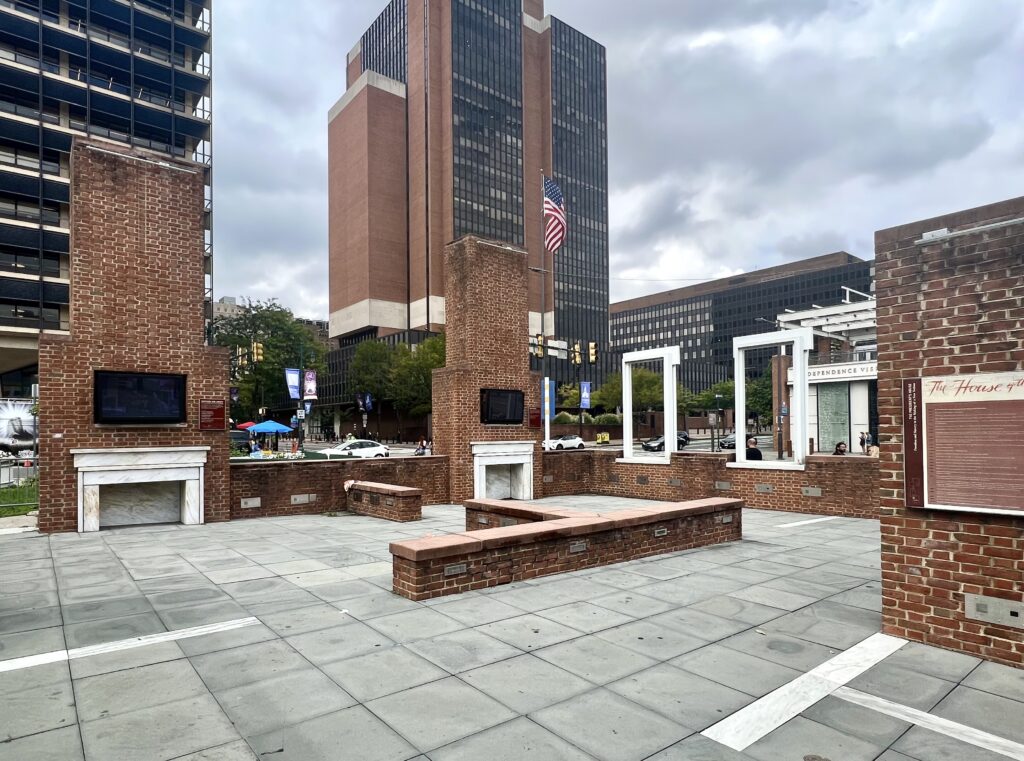
4. House of Washington & Adams
Just north of Liberty Bell Center lies the former presidential home of George Washington and John Adams. They resided here from 1790 to 1800 when Philadelphia was the U.S. capital.
The building no longer stands, torn down in 1832. But archaeologists have exposed some of the foundations.
You can explore the preserved footprint. Exhibits delve into Washington’s complex relationship with slavery during the presidents’ time in Philadelphia.
The open-air exhibit is free to visit and offers crucial insights into both Philadelphia’s and America’s history.
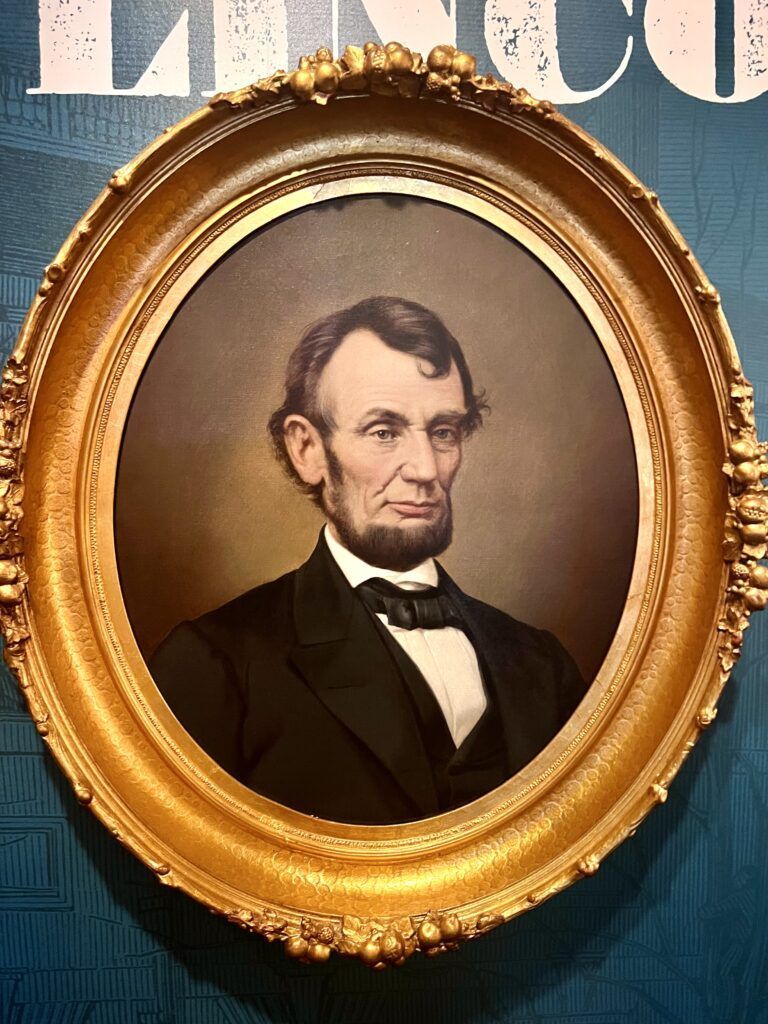
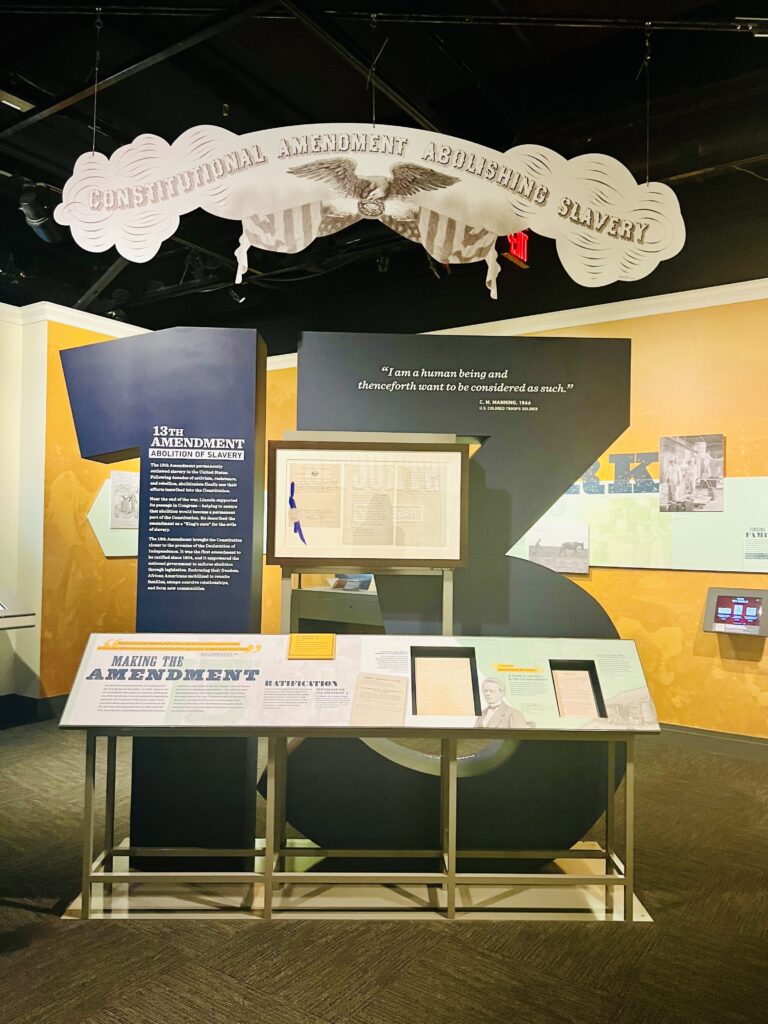
5. National Constitution Center
The National Constitution Center is the only museum dedicated to the US Constitution.
You should start with its theatrical performance, Freedom Rising, to get the historical backdrop. It’s a 10 minute live multimedia production that will definitely get your patriotic juices flowing. It’s poignant and moving.
On the ground floor, you can lean about the American Revolution and the Civil War through rare artifacts.
Exhibits delve into the paradox of liberty and slavery, the anti-slavery movement, and women’s right to vote. Among other things, you’ll see portraits of Abraham Lincoln, a cast of his hands, Sandra Day O’Connor’s judicial robe, and a Ku Klux clan uniform.
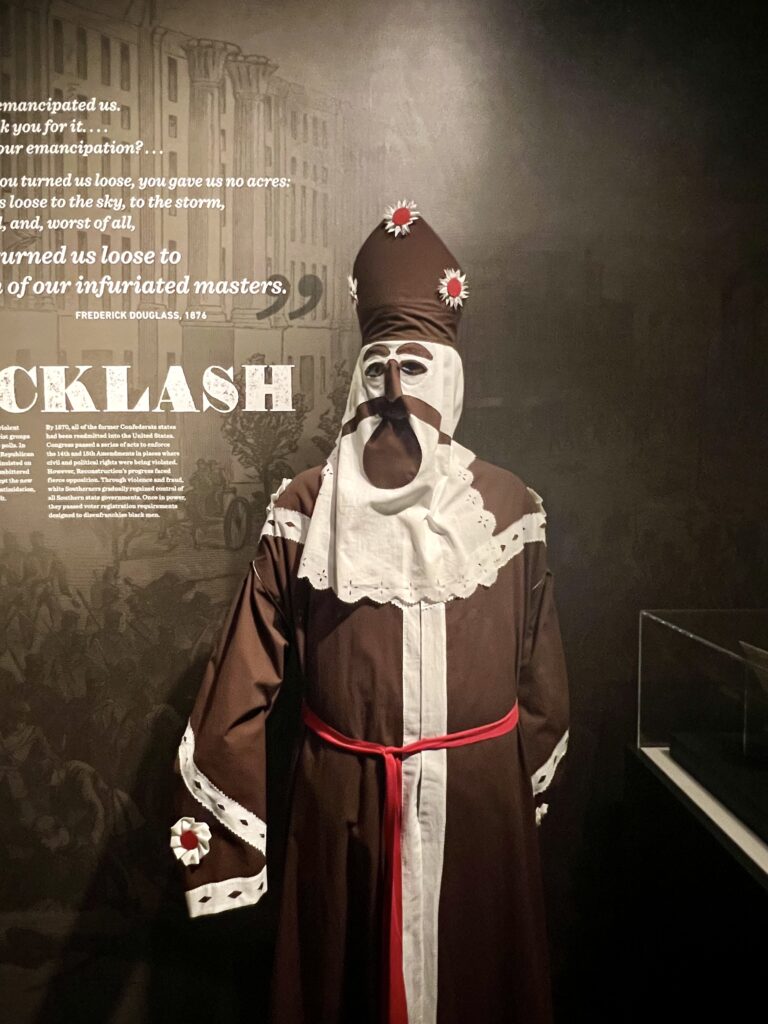
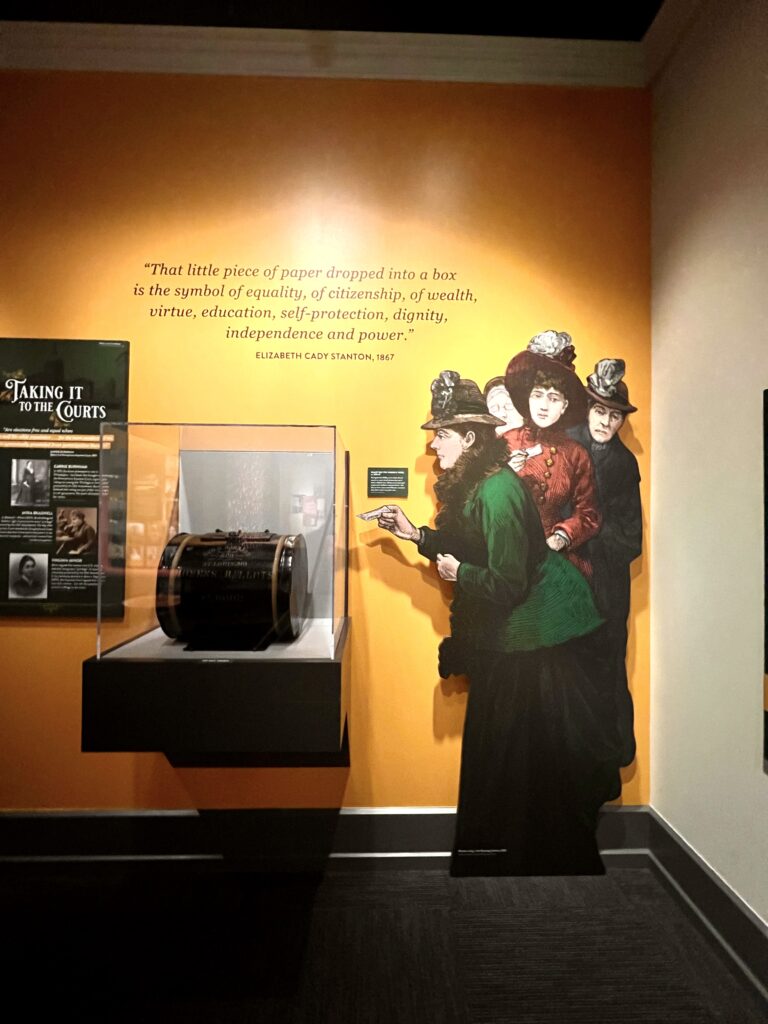
Upstairs, there’s a First Amendment exhibit and you can visit Signers’ Hall.
This is an amazing immersive room. There are 42 life size statues of the men who signed the US Constitution on September 17, 1787 (along with the three dissenters).
The statues were created by 50 artists from Studio EIS in Brooklyn NY. Each one is based on extensive historical research, including the known descriptions of the delegates and their clothing, hairstyles, and accessories.
The statues are so lifelike that you’ll recognize many of the men straight away.
While towering in gravitas, most of these men were short in stature, except for George Washington. Madison is a good head shorter than him.
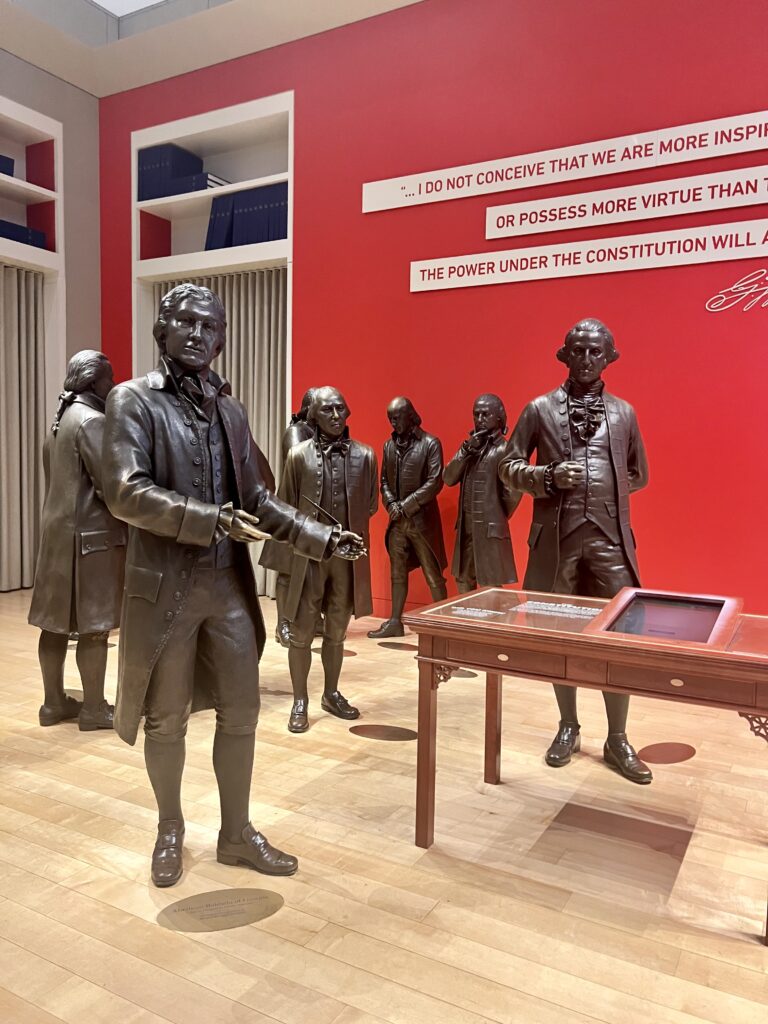
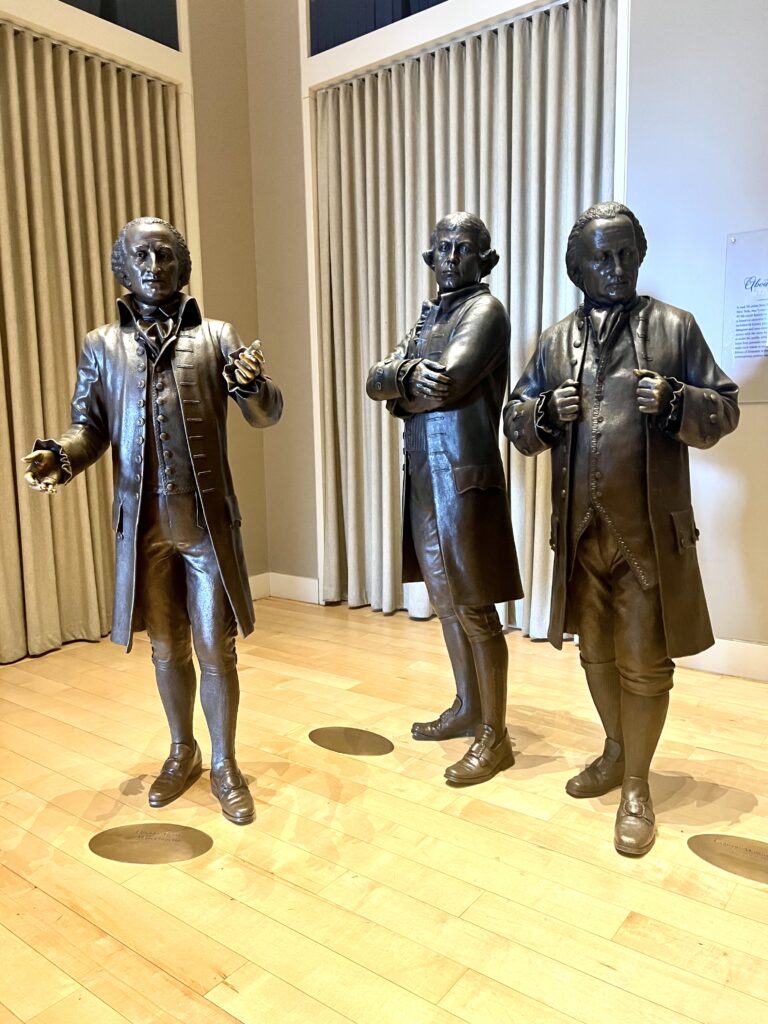
The docents are wonderful and full of information and facts. I was encouraged to take a selfie with Washington and dance with a dissenter.
The exhibit features a high-quality digital version of the entire Constitution, including all the amendments. It also has one of the 20 originals too, but it’s so fragile that it’s not often on display.
Visitors can explore the text, learn about its history, and even sign their names electronically.
There are interactive exhibits throughout the museum and programs that focus on the U.S. Constitution and its impact on American history and government. You can vote on Supreme Court cases, swear the presidential oath of office, and sign the constitution.
>>> Click here to book a constitution walking tour
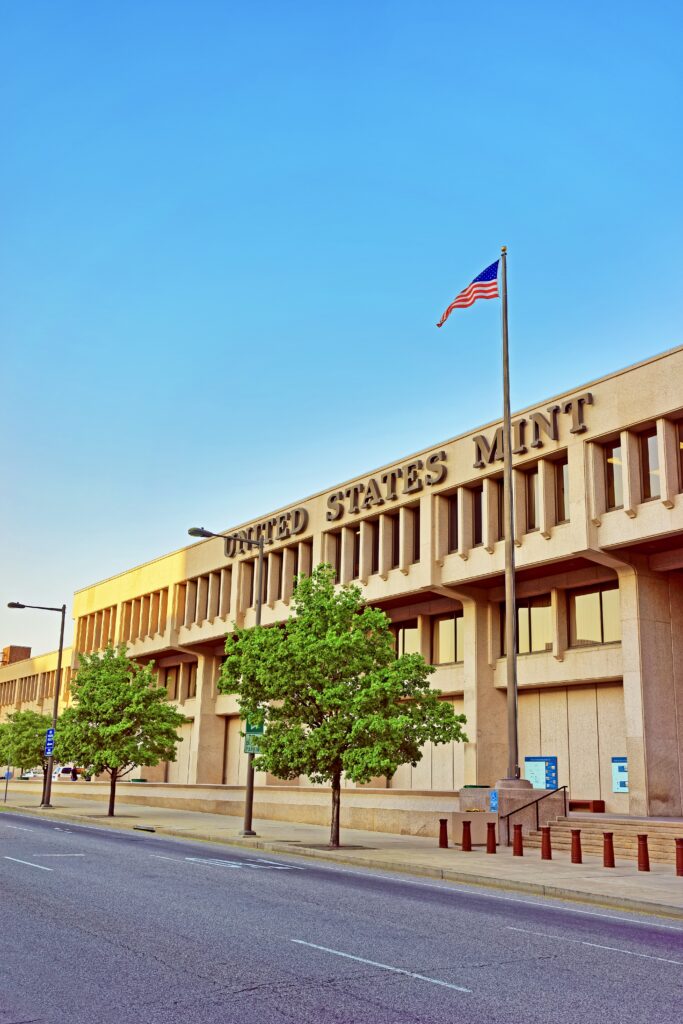
6. US Mint
Right next door to the National Constitution Center is the US Mint. It stands where the Female Anti-Slavery Society once had its headquarters.
The Mint is housed in an impressive neoclassical structure designed by architect William Strickland. It features a prominent portico with Doric columns and a classic design that reflects the principles of the early republic.
It began operating in 1793 and is one of the oldest facilities responsible for producing and circulating coinage in the US.
Most tours start in the visitor center, where you can watch a short introductory film about the US Mint and its operations. On a tour, you’ll learn about the history of coinage, the coin production process, and the significance of the mint in American history.
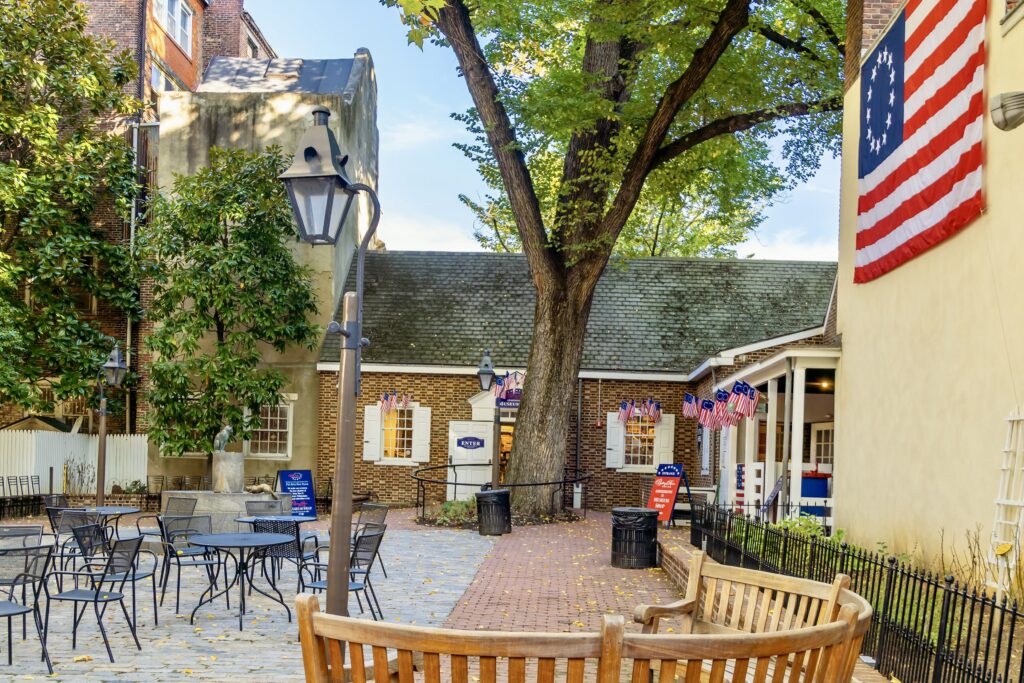
7. Betsy Ross House
The Betsy Ross House is a must visit on any visit to Independence Park. It’s the house where Ross rented rooms and plied her trade as a seamstress and upholsterer.
Nicknamed the “Little Rebel,” Ross was a lady with revolutionary spirit. Indeed, she’s one of the most famous women in American history.
But she didn’t lead an easy life. Ross was born in 1752 on a farm. Her Quaker and family and friends shunned her when she married a man of a different faith. She was widowed three times.
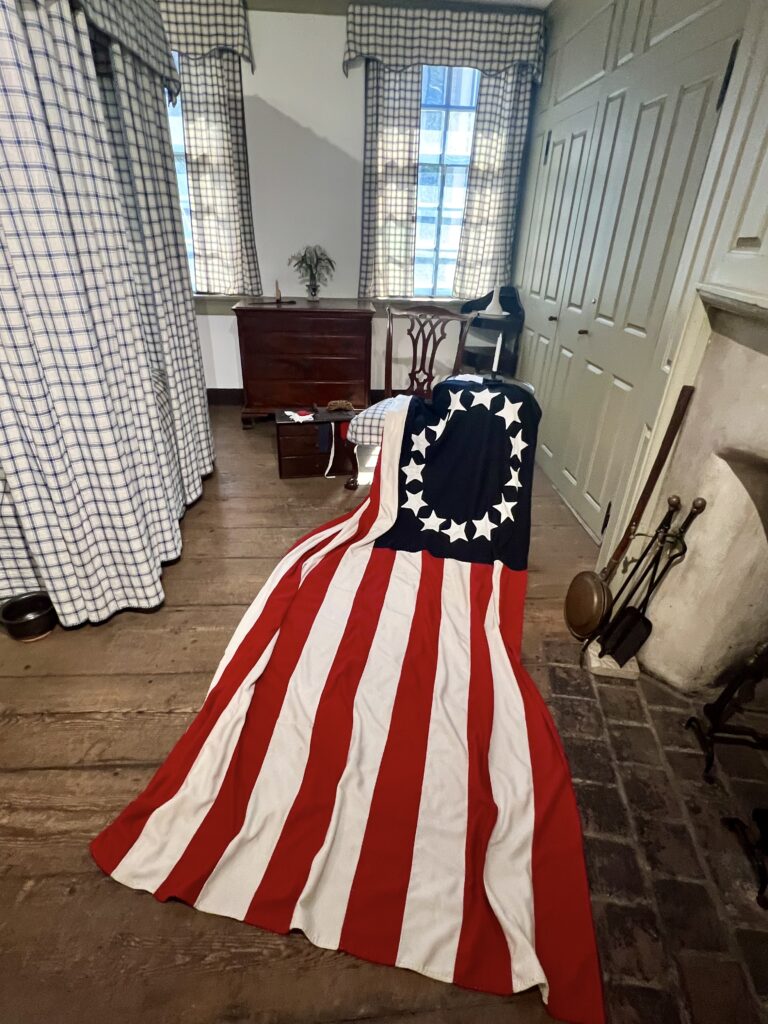
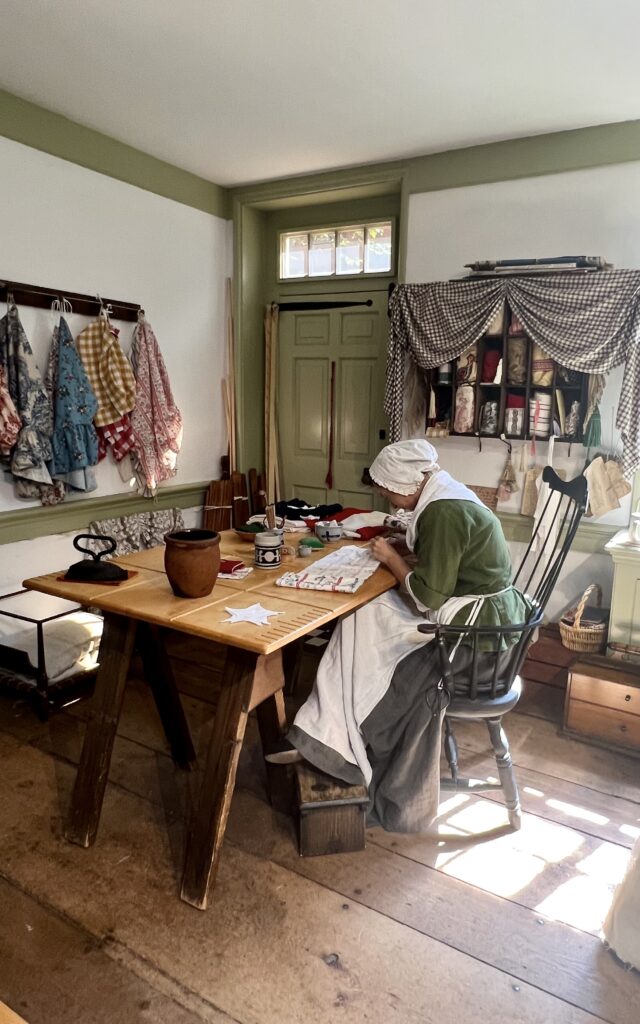
Despite these difficulties, Ross was still a successful entrepreneur, running her own business and supporting her family.
According to legend, George Washington asked her to create the nation’s first Stars and Stripes flag. Washington reportedly wanted a 6 pointed star. But Ross folded a piece of paper and, in one snip, created the 5 pointed star used today.
On your tour, you can see Ross’ bedroom, the upholstery shop, the flag room, and the winter kitchen. The original flag no longer exists, but you will see a replica flag. The tour ends outside at Ross’ grave.
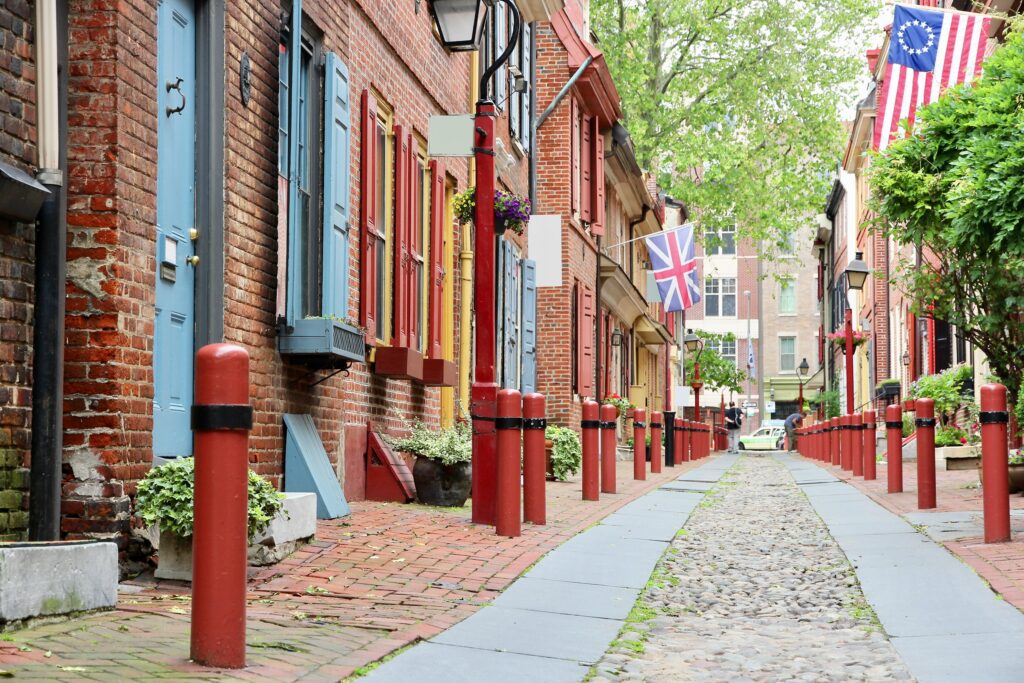
8. Elfreth’s Alley
Elfreth’s Alley is one of the most beautiful lanes in Philadelphia. It’s the country’s oldest continuously inhabited residential block. It’s similar to Acorn Street in Boston’s Beacon Hill neighborhood.
There is an exceptional collection of 32 early American buildings on the narrow cobblestone street. 29 of them are privately owned and signs ask you to respect their privacy.
The lovely Colonial homes were built between 1720 and 1830. They once housed tradesmen, smiths, and glassblowers.
There’s a tiny museum on the lane dedicated to the everyday American. Residents open their homes twice a year to the public.
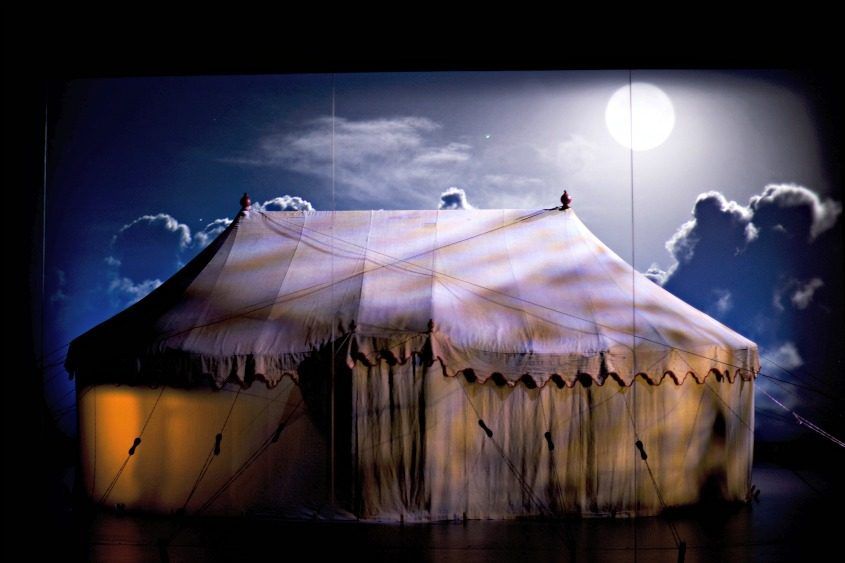
9. Museum of the American Revolution
The Museum of the American Revolution is a institution dedicated to preserving and presenting the history of the American Revolution.
It takes you on a chronological tour of the nation’s early history from the years of British America, to the resistance, to the role of George Washington, to the long and drawn out Revolutionary War and its aftermath.
Visitors can explore a diverse range of artifacts (weapons, uniforms, documents, artworks), immersive exhibits, and interactive displays that vividly bring to life the nation’s struggle for independence.
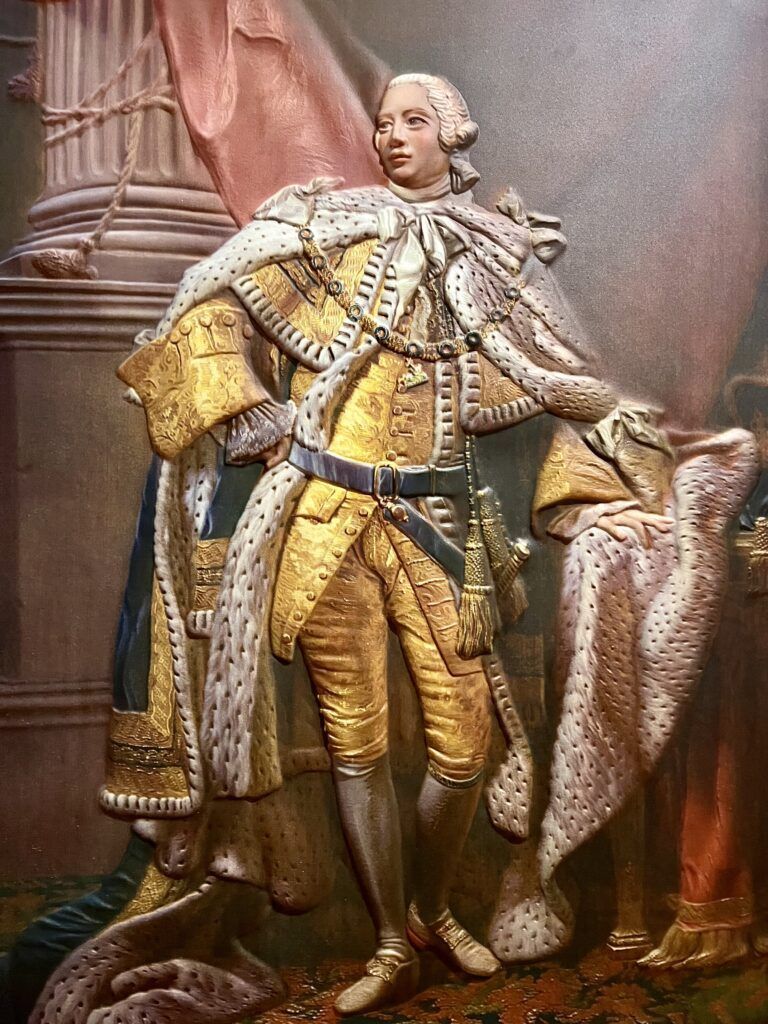
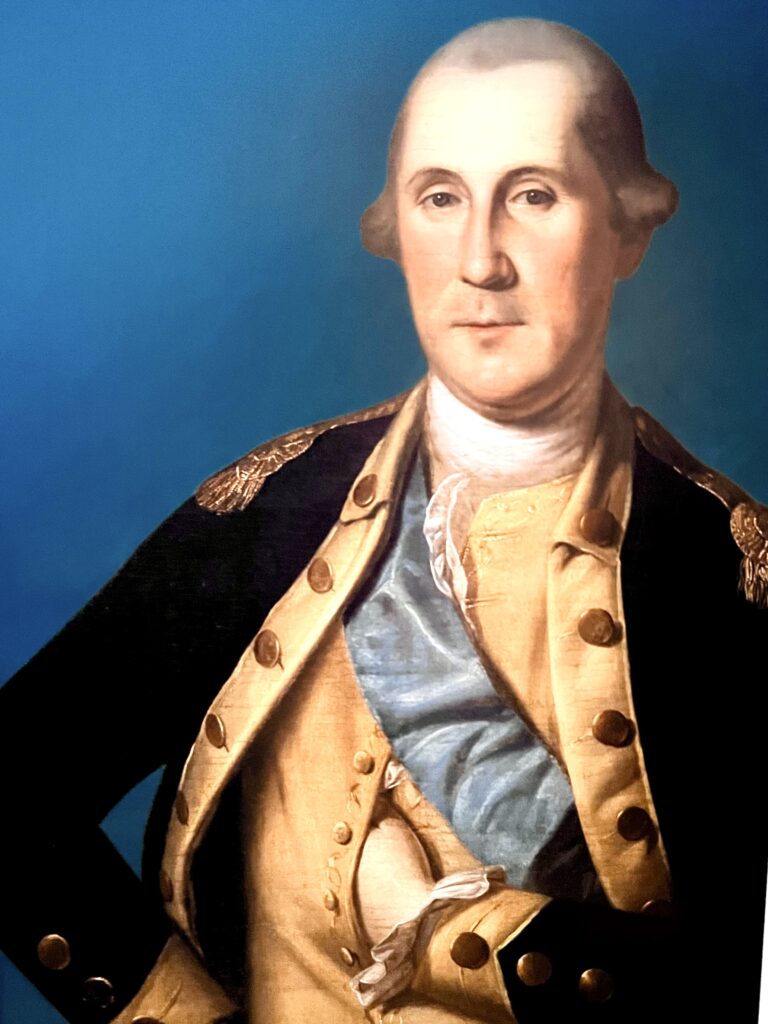
Highlights include two historic ships, a 1770s war mug that smells of rum, Washington’s headquarters flag, and booties made from a Redcoat’s jacket.
One of the museum’s most iconic artifacts is George Washington’s field tent. It served as his mobile headquarters during the Revolutionary War. The tent is beautifully preserved and displayed in a specially designed theater.
In 2016, the museum installed a recreation of America’s first Liberty Tree. This symbolic tree features hanging lanterns representing the 13 original colonies.
If you are a history buff, and want to read everything, you could easily spend 2-3 hours in the museum.
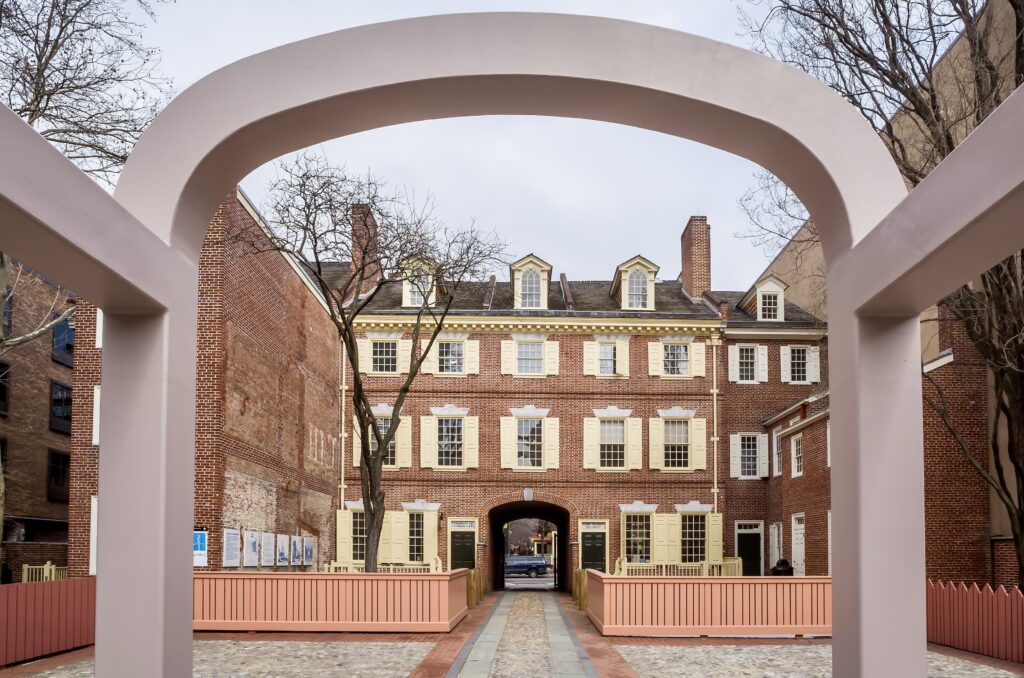
10. Benjamin Franklin Museum & Franklin Court
Located at 317 Chestnut Street, the Benjamin Franklin Museum stands where Benjamin Franklin’s home once was in the 18th century. This museum is all about celebrating the life and accomplishments of Benjamin Franklin, one of America’s founding fathers.
When you visit, you’ll discover interactive exhibits, artifacts, and videos that tell the story of Franklin’s life. He was essentially a modern day Renaissance man — statesman, inventor, and writer.
You’ll learn about his famous electricity experiments, his important role in the American Revolution, and how he shaped American society.
Did you know Franklin started the U.S. Postal Service and became the first Postmaster General in 1775? They still use a special B. Free Franklin stamp on cards and letters.
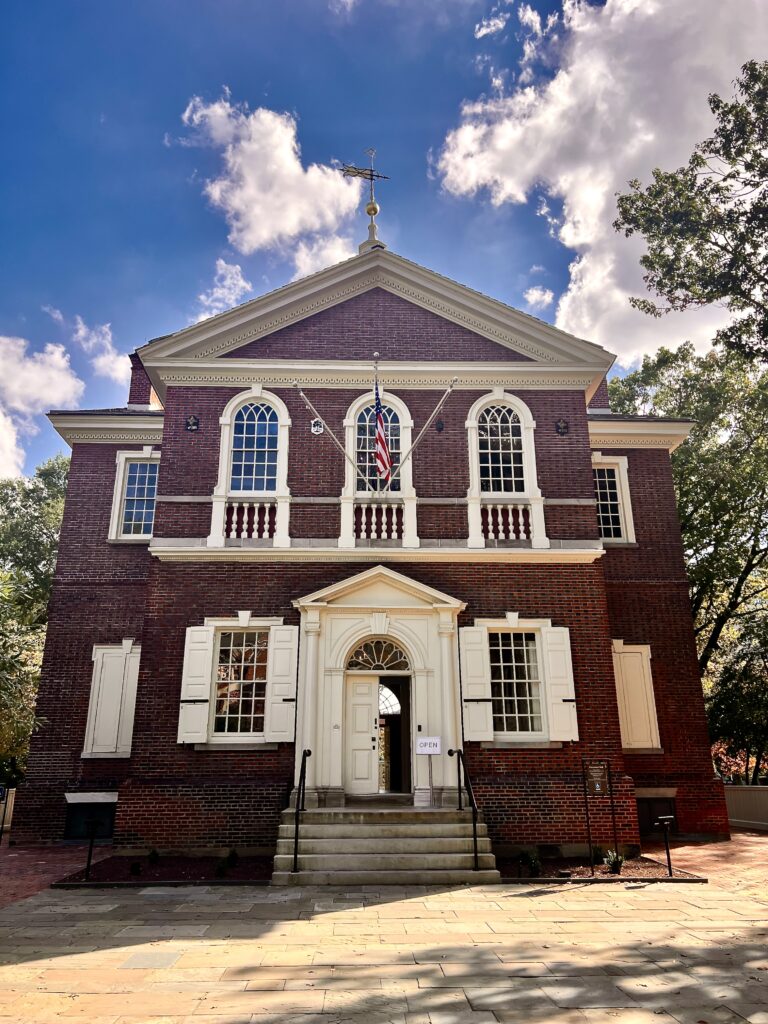
11. Carpenter’s Hall
Carpenters’ Hall was designed by architect Robert Smith and built between 1770 and 1774. The building features Georgian style architecture with a red-brick facade and white trim.
The hall was originally constructed to serve as the meeting place and offices for the Carpenters’ Company of the City and County of Philadelphia, a prominent guild of craftsmen and artisans.
However, it became famous for its role in the events leading to the American Revolution. This historic meeting hall is where the First Continental Congress met in September 1774.
Delegates from 12 of the 13 colonies (excluding Georgia) gathered here to air their grievances with British rule and to formulate a united response.
Carpenter’s Hall is open to the public for free visits and hosts various exhibits and events related to American history. You’ll see hand tools, historic artifacts, and chairs used by the founding fathers.
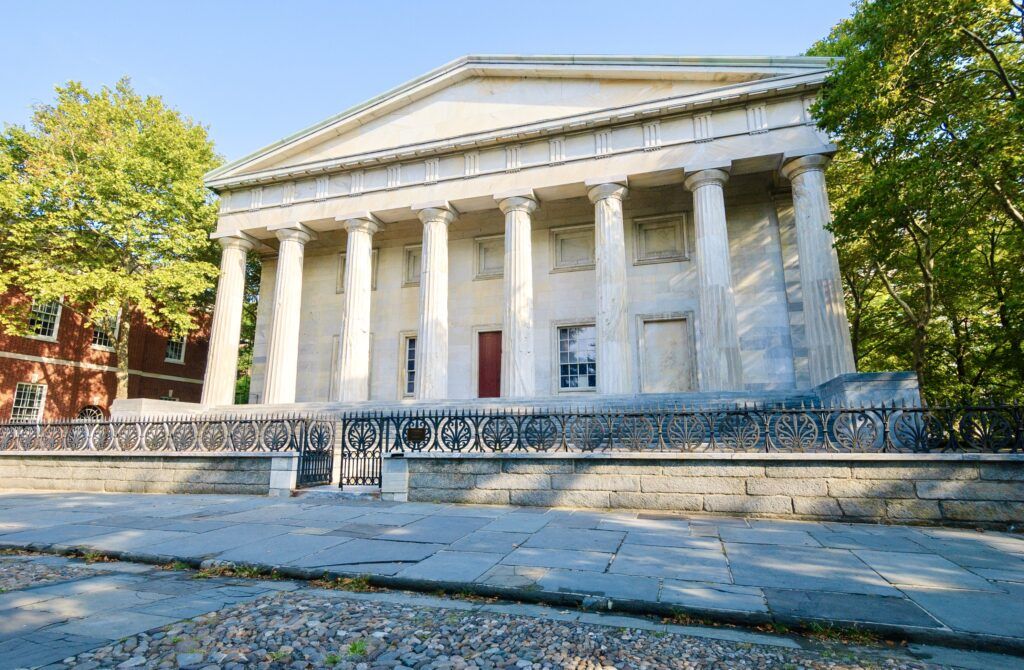
12. Second Bank of the United States
This beautiful Greek Revival style building was designed by William Strickland and built in 1819-84. Today, it houses the Portrait Gallery of the American Philosophical Society.
It features a People of the Independence exhibit with a collection of over 180 18th and 19th century portraits. And it’s perfectly free to visit.
A whopping 84 of them are by one of America’s greatest portraitists, Charles Willson Peale. The most famous ones are his portraits of George Washington, Alexander Hamilton, and Thomas Jefferson.
The main gallery is a large barrel vaulted space, with smaller rooms grouped by topics. This gallery is a hidden gem where you can enjoy great art in peace.
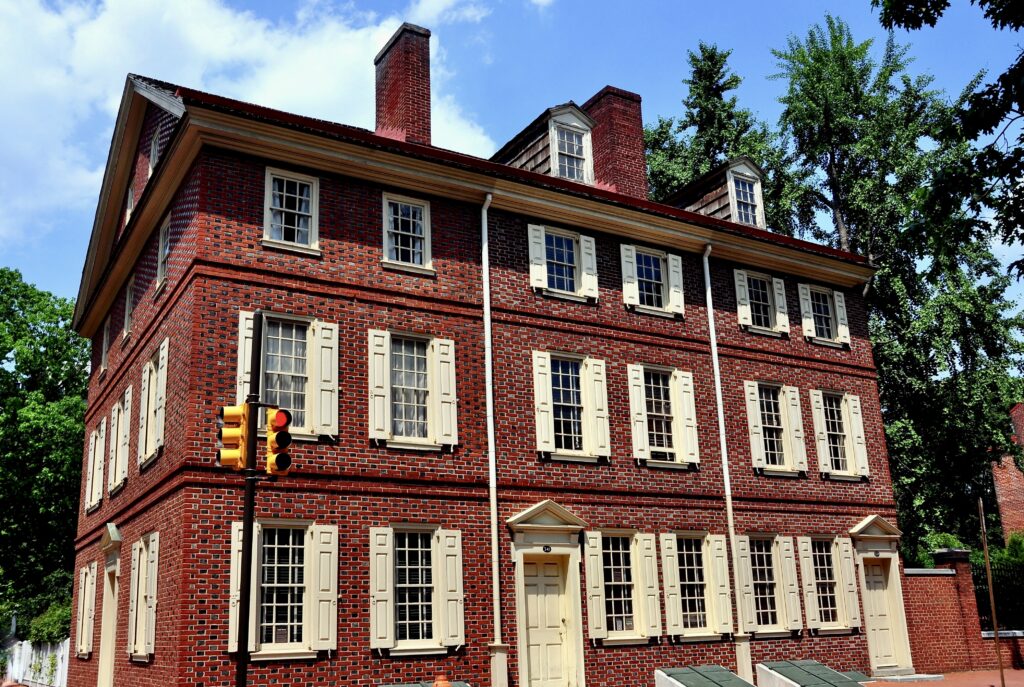
13. Dolley Todd House
The Todd House was the residence of Dolley Todd Madison, one of the most influential First Ladies in American history.
She was the wife of President James Madison and played a key role in shaping the role of First Lady. Today, her house is a museum showcasing her life.
The Todd House has been preserved to reflect the early 19th century period when Dolley Madison lived there. You can see period appropriate furnishings, decor, and artifacts that provide a glimpse into the lifestyle of the Madison family during that time.
Entry to the house is by guided park ranger tour only. A free ticket is required to enter. They are given out on the day of the tour on a first come first serve basis, starting at 8:30 am at the Independence Hall Visitor Center.
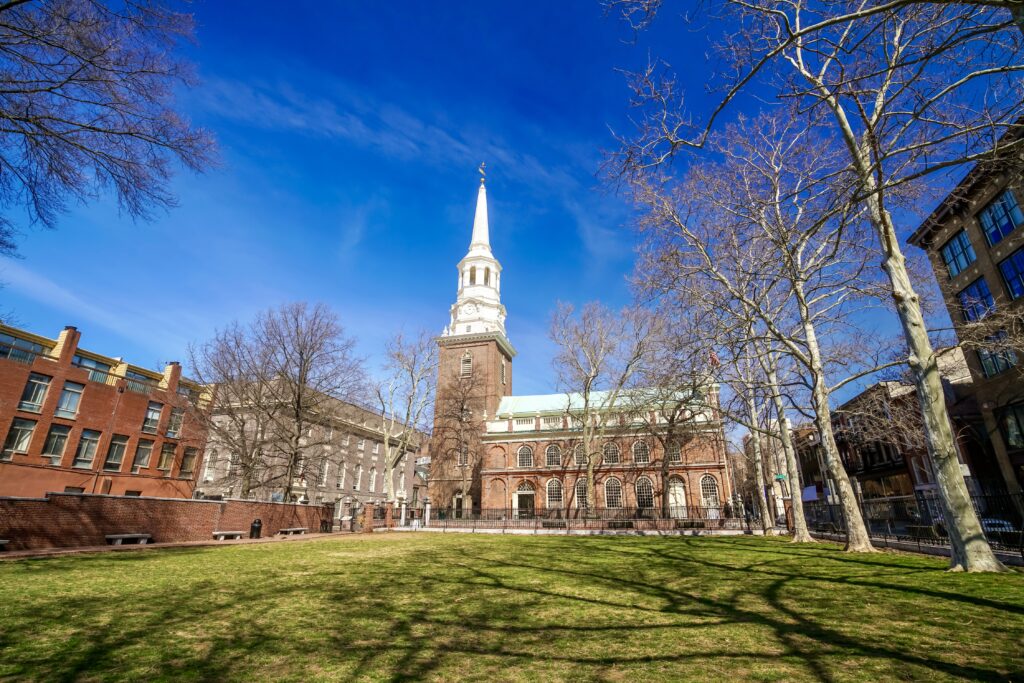
14. Christ Church
Founded in 1695, Christ Church is the oldest and first Anglican Church in the United States. It was once called “the nation’s church.” The current building dates to 1744 and is the finest example of an Early American church.
Notable worshipers included George Washington, Benjamin Franklin, William Penn, John Adams, Betsy Ross, and signers of the Declaration of Independence.
The church is a beautiful Georgian-style red brick facade with white trimmings.
The church’s steeple, which is one of the most iconic features of the building, rises gracefully into the sky. The steeple is crowned with a weathervane shaped like a rooster.
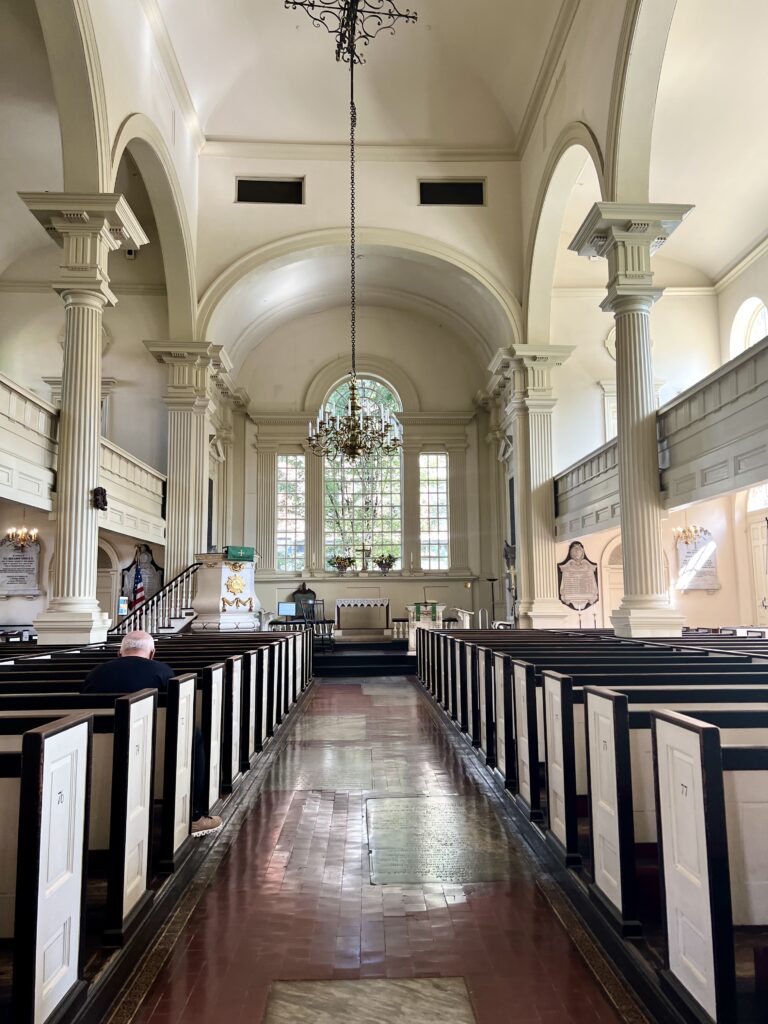
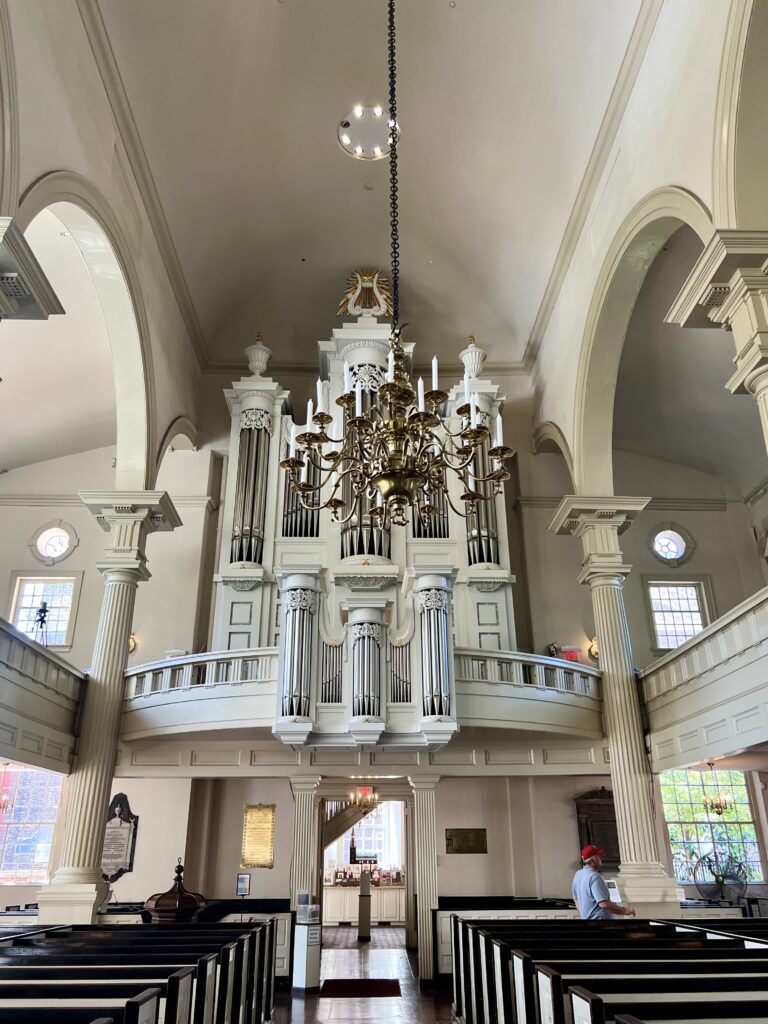
Inside, the church is gleaming white. It boasts a collection of original 18th century box pews, which were once reserved for prominent colonial families.
The chancel area, located at the front of the church, is the focal point of worship. It features a lovely altar, pulpit, and glass windows. The church also houses a historic pipe organ.
You can still see where George Washington sat. And you can see the baptismal font where William Penn was baptized.
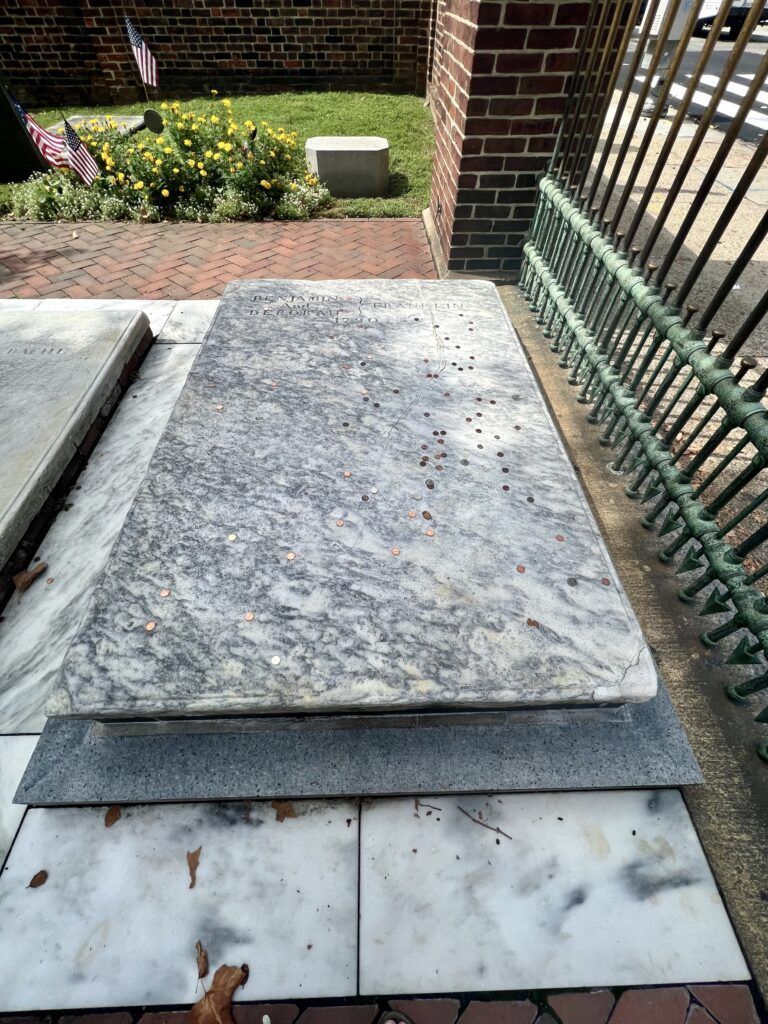
15. Christ Church Burial Ground
The Christ Church Burial Ground is their resting place of prominent Colonial leaders, including five signers of the Declaration of Independence and founders of the US Navy.
The most famous grave is Benjamin Franklin’s. You’ll recognize it because it’s covered with pennies.
If you don’t want to go inside, no problem. His grave his near the cemetery’s fence and you can see it from the sidewalk.
You can toss some pennies yourself, a nod to Franklin’s proverb that “a penny saved is a penny earned.”
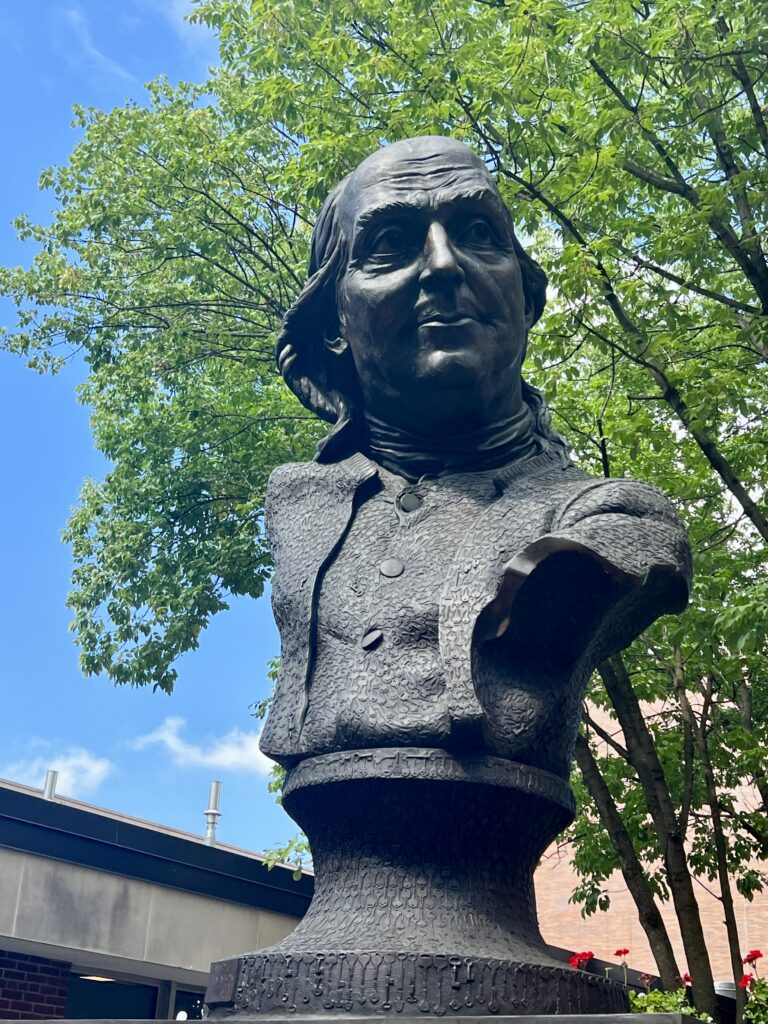
16. Keys To The Community Sculpture
You won’t miss this giant sculpture of Benjamin Franklin on Arch Street. It was sculpted by James Peniston and weighs one ton.
It was made with 1,000 keys and 1.8 million pennies collected by local school children. It also contains several brass names representing Philadelphia firemen fallen in the line of duty since 1736.
The sculpture marks the entrance to Girard Fountain Park and the History of the Philadelphia Fire Department mural.
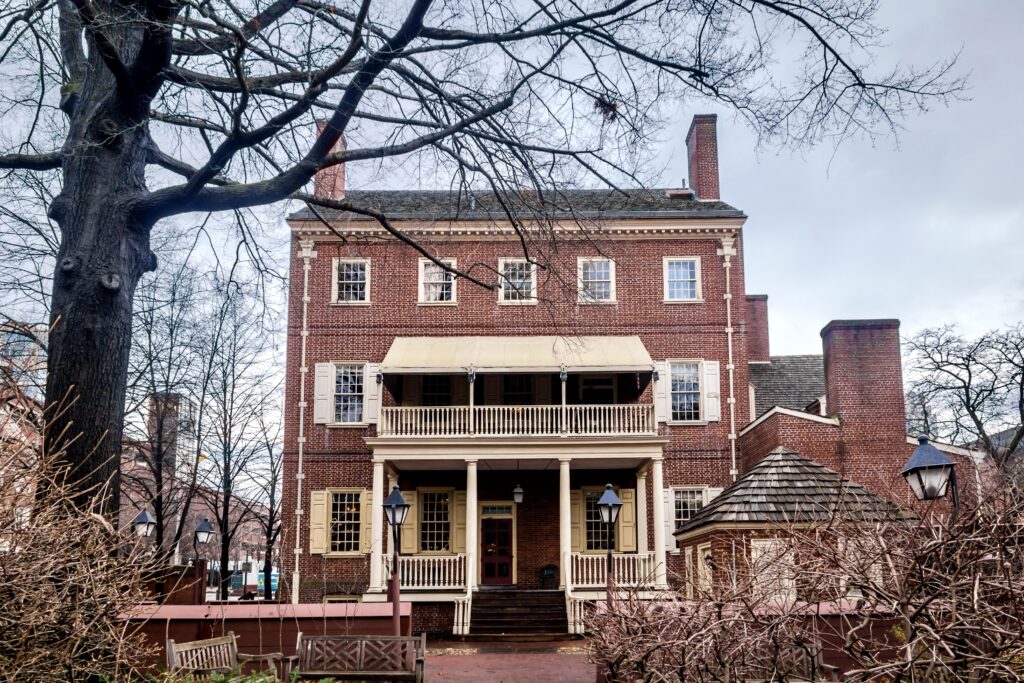
17. City Tavern
The City Tavern is a historic restaurant and pub in the park. The original 1773 tavern is long gone. But today an exact replica stands in its place.
In this building, Thomas Jefferson ate most of his meals and John Adams rented a room. Paul Revere rushed in here with news of the Boston Tea Party. It was called the “most genteel tavern in America.”
Legend holds that two ghosts haunt the grounds: a man killed in a fire and a waiter slain in a duel.
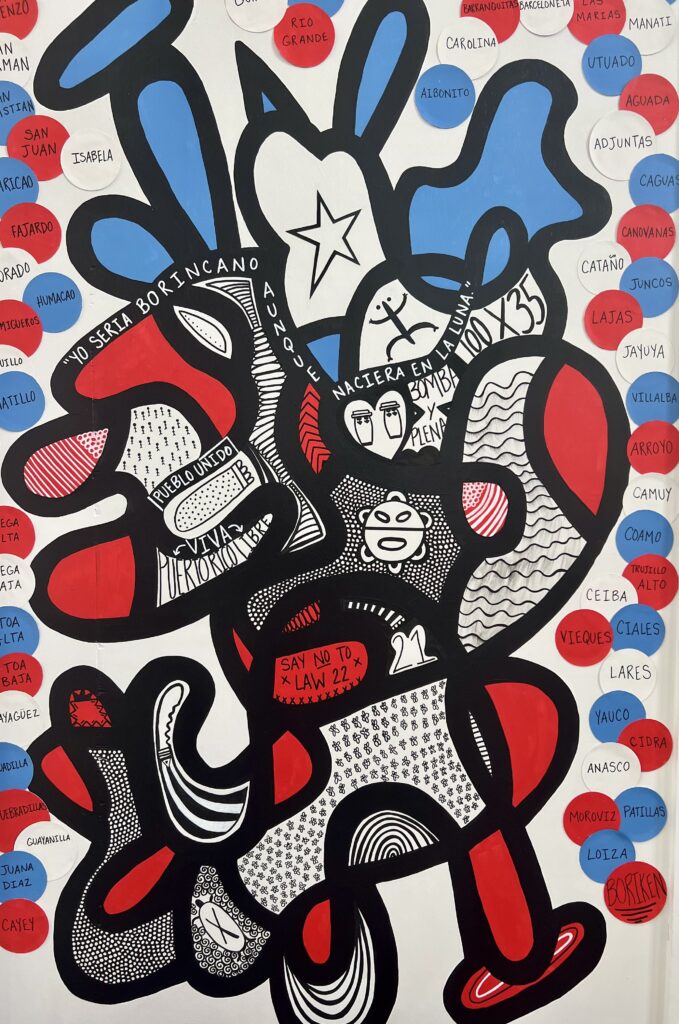
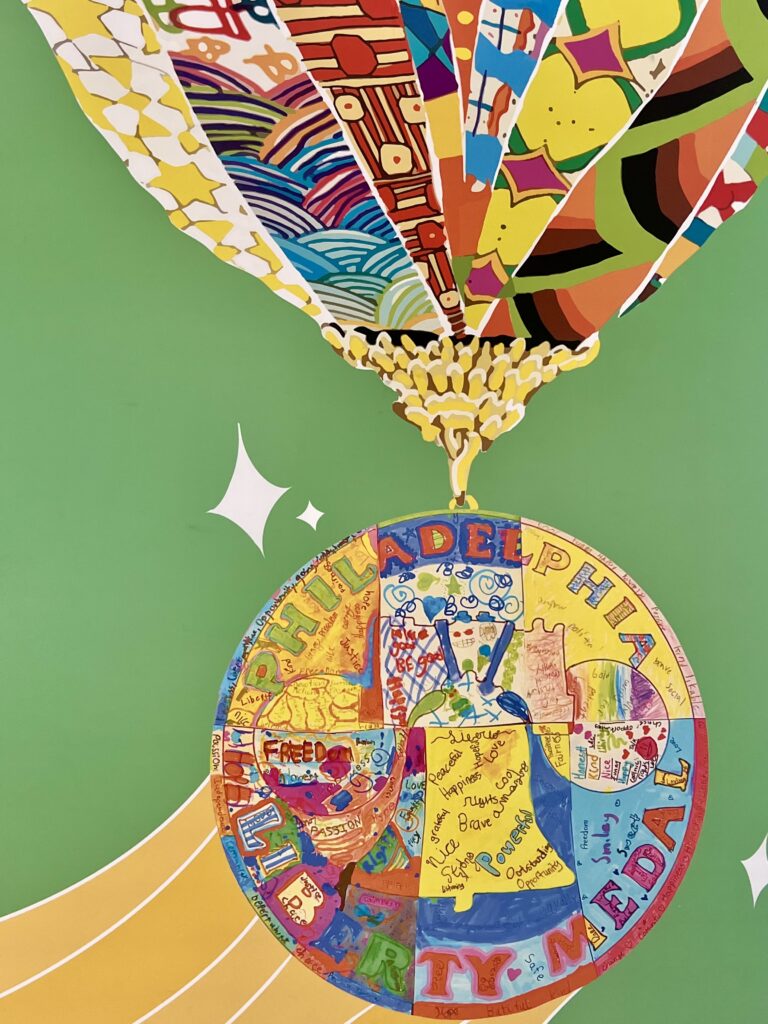
Practical Guide & Tips For Independence National Historical Park
Address: 143 S. 3rd Street, Philadelphia, PA 19106
Hours:
- Independence Hall: Open daily 9:00 am to 5:00 pm
- National Constitution Center: Open Wednesday through Sunday from 10:00 am to 5:00 pm
- Liberty Bell Center: Open daily 9:00 am to 5:00 pm
- Betsy Ross House: Open daily 9:00 am to 5:00 pm
- Museum of the American Revolution: Open daly 9:00 alto 5:00 pm
How To Get There:
By Car: If you’re driving, there are parking lots and garages in the vicinity. But parking can be limited, so it’s a good idea to arrive early.
Public Transportation:
Philadelphia has an excellent public transportation system, SEPTA. You can take buses, trolleys, or the Market-Frankford Line (the “El”) to nearby stops. The 5th Street/Independence Hall Station is close to the park.
You can also take the Hop on Hop Off Tourist Bus. You can also buy tickets for the bus on 6th Street in the park.
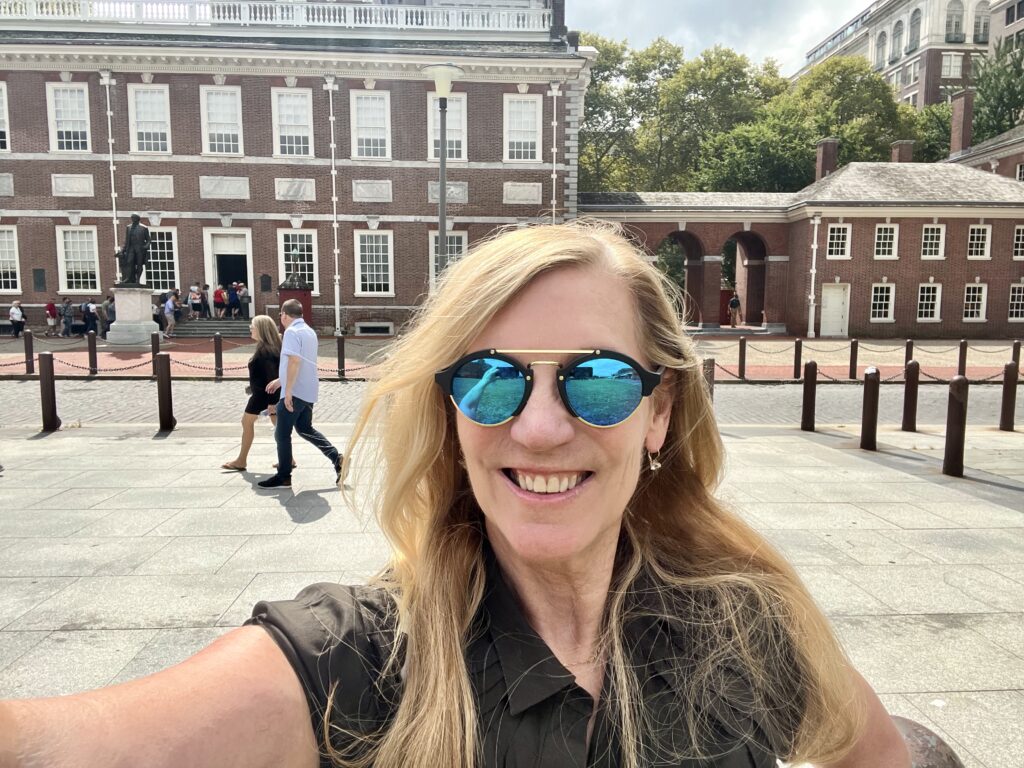
Walking: If you’re staying in the Center City or Old City, Independence National Historical Park is easily accessible on foot. It’s a pedestrian-friendly area with well-marked paths.
Visitor Center:
There is a visitor’s center in the park. You can pick up information pamphlets, see a welcome video, touch a replica of the Liberty Bell, and admire the rising chair. You can also get the requisite selfie with Rocky.
There are also rest rooms, casual eateries, and a gift shop.
How Long To Spend At The Park
With so many sites to see, you could easily spend an entire day at the Independence National historical Park and exploring Old City.
If you are pressed for time, choose between the National Constitution Center and the Museum of the American Revolution, which have some overlap. I would personally choose the former.
I hope you’ve enjoyed my guide to visiting Independence National Historical Park. You may enjoy these other Philadelphia travel guides:
- 2 Days in Philadelphia Itinerary
- Top Attractions in Philadelphia
- Guide to the Philadelphia Museum of Art
- Guide to Philadelphia’s Rodin Museum
- Guide to Eastern State Penitentiary
- Guide to The Barnes Foundation
- Guide to the Mütter Museum
- Guide to the Betsy Ross House
If you need a guide to Independence National Historical Park, pin it for later.

